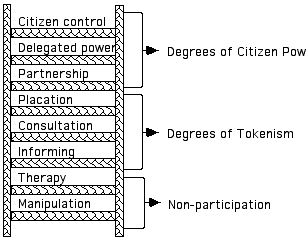|
|
Ladder of Participation
Sherry Arnstein describes various types of public participation and 'non-participation' in terms of a hierarchy based on the degree of participation involved. On the bottom of her ladder are two forms of non participation; manipulation and therapy. Therapy pretends to involve people in planning in order to help those people feel better about themselves; manipulation is also a facade of participation and is concerned to 'educate' people or get them on side. The next three levels, Arnstein describes as degrees of tokenism. Informing involves the use of the media, pamphlets and posters to provide a one-way flow of information. Consultation allows citizens to express their views but there is no guarantee that those views will be considered or taken into account. Placation allows some influence to citizens through token membership of committees or boards. The three highest levels which involve real participation involve a redistribution of power.
|

